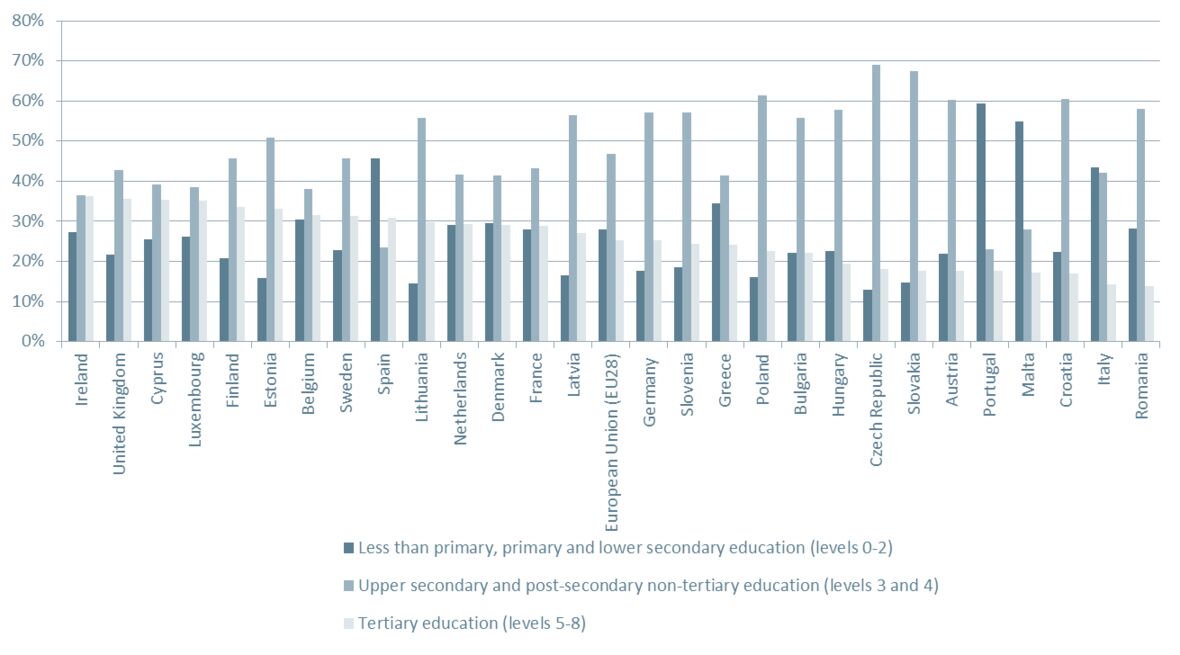Economic Context
Working population
The Grand-Duchy of Luxembourg has a population of 645.397 inhabitants (1st of January 2022) with a population growth of 1.7%. The growth since 1991 is more than 67%. The proportion of foreigners is about 47.1% of the total population. 170 nationalities live in Luxembourg; 81% of the foreign population are nationals of another European country. 69.4% (2021) of the population is in the working age, being between 15 and 64 years. The unemployment rate is 4.7% (April 2022). The total domestic employment is composed of 499.100 employees (March 2022) with around 74% of the country’s workforce composed of immigrants or cross-border employees. The ratio of cross-border employees grew from 3% in 1961 to 47% in 2022.
Sectors of the economy
The VET offer reflects the needs of the Luxembourgish economy, represented by the social partners through the professional chambers for employers and employees. Stakeholders are closely involved in the definition of the VET offer and the suggestion of new trades and professions in the framework of the VET steering committee (groupe de pilotage). Sectorial representatives are also part of the curricular teams (équipes curriculaires) and national vocational committees (commissions nationales de formation). A curricular team is composed of experts from the educational side and from the labour market and is in charge of a specific trade or profession, or of a group of trades or professions. Hence, through labour market experts the economic sectors closely cooperate in the definition of the learning outcomes to be developed and assessed in a specific VET programme.
Labour market structure and development
Luxembourg's economy has undergone intensive structural changes in the last decades.
From an industrial economy, it evolved into an economy where the tertiary sector prevails. Between 1995 and nowadays, the structure of the Luxembourgish economy has been continuously shifting in 1995, the industrial sector still accounted for almost 20% of employment, while in 2021 it represented only 8%. Moreover, the sectors grouped under "Information and communication", the " Specialized activities and support service activities
" and the " Administrative and support service activities " sector experienced strong growth. The employment in the " Specialized activities and support service activities " sector has more than doubled, from 7.9% in 199 to 16.5% in 2021
Educational attainment
In Luxembourg, according to the last figures from Eurostat,[1] the percentage of People with at least an upper secondary educational attainment is very close to the EU average (75%). However, Luxembourg stands out from most of the EU countries with the second highest proportion of people having a tertiary level of education: 45% of the population while the EU average is nearly 30%. It reflects the economic structure of the country, which is strongly oriented towards high-skill sectors.
Regarding vocational education, Luxembourg is close to the EU average. For the school year 2021-2022, among the 21533 pupils registered in the upper secondary levels, nearly one third opted for vocational training.

As shown in the above figure (Source: Eurostat, 2015, Table: lfsa_pgaed), the share of the population that has completed tertiary education is amongst the highest in the European Union. The share of the population with a level of education below primary and lower secondary education is close to the EU28 average. Finally, the share of population with an upper secondary level is lower than the EU28 level.
Business environment
Luxembourg’s economy ranks high on the ease of doing business index of the World Bank compared to the neighbouring countries and the regional average. It also ranks higher than France and Belgium on the ease of starting a business index, but slightly lower than Germany.
As the following figure shows, Luxembourg’s economy is characterized by small and medium sized enterprises with less than 249 employees.
| 0 employees |
1-4 |
5-19 |
20-49 |
50-249 |
Over 250 |
|---|---|---|---|---|---|
| 14365 | 10196 | 5284 | 1294 | 709 | 158 |
| companies |
(STATEC 2015)
Regional differences
Regional differences
No real differences exist in the Grand-Duchy of Luxembourg because of the limited area of 2’586 square kilometres. The Grand Duchy of Luxembourg extends from north to south over a maximum distance of 82 km and 57 km from east to west. Regarding education and training programmes, there are no regional differences as the system is centralised and regulated by the Ministry of Education, Children and Youth.